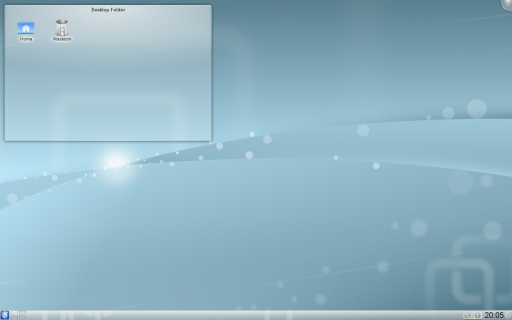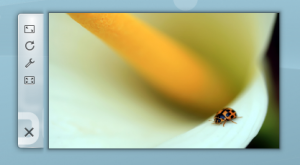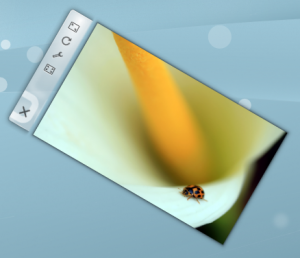Plasma/da: Difference between revisions
Created page with '(Endnu ikke skrevet)' |
Created page with '=== Aktiviteter og Zooming User Interface (ZUI) ===' |
||
| Line 101: | Line 101: | ||
(Endnu ikke skrevet) | (Endnu ikke skrevet) | ||
=== | === Aktiviteter og Zooming User Interface (ZUI) === | ||
KDE Plasma has brought a lot of new features to the modern linux desktop, however many people are only using a fraction of the desktop's full potential. One of the most useful and underused features is the plasma activities. The basic idea behind is that your desktop space is limited to how many widgets it can hold. A user will want to use a lot of widgets but doesn't want their desktop to be cluttered. The answer to this problem is activities; they allow you to specialize each desktop to whatever task you need to accomplish. To make a new activity you have to click on the toolbox in the upper right hand corner, from there click zoom out. The desktop will zoom out then click add new activity under the small desktop. It will make a new desktop right next to it. Now go click the zoom in button under the new desktop. With this desktop you can add whatever widgets to this desktop and it will not affect the other desktop. | KDE Plasma has brought a lot of new features to the modern linux desktop, however many people are only using a fraction of the desktop's full potential. One of the most useful and underused features is the plasma activities. The basic idea behind is that your desktop space is limited to how many widgets it can hold. A user will want to use a lot of widgets but doesn't want their desktop to be cluttered. The answer to this problem is activities; they allow you to specialize each desktop to whatever task you need to accomplish. To make a new activity you have to click on the toolbox in the upper right hand corner, from there click zoom out. The desktop will zoom out then click add new activity under the small desktop. It will make a new desktop right next to it. Now go click the zoom in button under the new desktop. With this desktop you can add whatever widgets to this desktop and it will not affect the other desktop. | ||
Revision as of 06:54, 30 July 2010
Template:I18n/Language Navigation Bar
En introduktion: hvad Plasma er, og hvad den gør
Plasma er skrivebordsbrugerfladen for KDE SC 4 med startmenuen, skrivebordet og skrivebordspanelet (ofte kaldet opgavelinjen, selvom denne kun er en del af panelet).
Plasma i overblik
Et typisk Plasma skrivebord ser sådan ud:

Et Plasma skrivebords tre nøglekomponenter er:
- Panelet, også kendt som opgavelinjen, som indeholder startmenuen, listen af tasks (programmer), ur and systembakken;
- Skrivebordet, arealet hvor widgets pg ikoner er placeret;
- Plasma værktøjskassen, som findes i det øverste, højre hjørne af skærmen. Der er også en i højre side af panelet.
Hvordan du finder rundt i Plasma
Du kan bruge Plasme på samme måde som andre styresystemers skriveborde: applikationer kan startes fra startmenuen (K Menuen), kørende applikationer vises i opgavelinjen, ikoner i systembakken giver forskellige informationer og så videre.
En vigtig del af Plasma er de såkaldte widgets. Widgets er skrivebordets enkelte dele; de omfatter blandt andet startmenuen, ikoner, systembakke, ur... Widgets kan findes på selve skrivebordet eller indsættes i et panel. Paneler og skriveborde er faktisk selv en slags widgets, som er beregnet til at indeholde andre widgets (i Plasma kaldes de Containments).
Hvad betyder det for brugen af skrivebordet? Plasma har nogle nye funktioner i forhold til traditionelle skriveborde. Vi har allerede nævnt Plasmas værktæjskasser, undertiden kaldet "cashew'erne": de er en måde at påvirke og indstille Plasma. Klikker du på dem, så dukker der en menu op på skærmen med en række valgmuligheder: du kan tilføje widgets til dit panel eller skrivebord, ændre størrelse, tilføje eller fjerne paneler med mere.
Skrivebordet og ikoner
Som du måske bemærkede på skærmbilledet er der ingen ikoner placeret direkte på skrivebordet. I stedet er de placeret i en beholder kendt som en Mappevisning. Selvom der er mange tekniske grunde til at gøre det på den måde, så kan Mappevisninger fungere fuldstændigt som erstatninger for skrivebordet (faktisk viser de mappen Skrivebord som standard). Du kan trække ikoner til dem, klippe, kopiere, indsætte, omdøbe filer og lave nye mapper og filer.
Der er to vigtige forskelle til det sædvanlige skrivebord:
- Du kan have mere end en Mappevisning af selve skrivebordet;
- Du kan indstille Mappevisninger til at vise andre mapper (både lokale og på netværket).
Ud over Mappevisninger kan du lægge alle mulige andre slags widgets på skrivebordet, som for eksempel vejrudsigts widgets, notat widgets, fil-overvågere... Der er ingen grænser for, hvordan du kan tilpasse dit skrivebord.
Widgets overalt
I KDE SC 4.x understøtter Plasma ikke blot widgets skrevet specielt til Plasma (også kendt som Plasmoider) men også widgets fra andre kilder som fx Google Gadgets og Dashboard widgets fra Mac OSX. Flere widgets findes og installeres let ved hjælp af Hent smarte nye ting.
Widgets, som er lagt ned i panelet har som regel en Opsætnings menu, mens dem på skrivebordet kan indstilles fra 'håndtaget', som dukker op på den ene side af widget'et når musen holdes svævende over det. Ved at trække i en fri del af håndtaget kan du flytte widget'et til den ønskede position.

Der er fire værktøjer i håndtaget. Det øverste indstiller størrelsen. Træk i dette værktøj for at ændre widget'ets størrelse.
Det næste værktøj drejer widget'et. Træk i det for at ændre orienteringen.

Den tredje er svensknøglen, som give dig mulighed for at redigere det aktuelle widgets indstillinger.
Det sidste værktøj bruges på nogle widgets, som for eksempel Billedrammen. Anvendt på en Billedramme vil dette værktøj åbne billedfremviseren.
Nogle af vore yndlingswidgets omtales på siden Plasma-widgets
(Endnu ikke skrevet)
Panelet

Du kan konfigurere panelet og tilpasse det til dine behov ved at klikke på værktøjskassen til højre i panelet.
Paneljustering: Lader dig indstille panelets placering til en af tre forud definerede positioner.
Altid synlig: Holder panelet synligt altid, selv når vinduerne er maksimerede.
Skjul automatisk: Gemmer panelet væk indtil musen placeres nær skærmkanten.
Vinduer kan dække: Dette lader vinduer dække panelet; hvis vinduer maksimeres vil panelet blive dækket.
Vinduer går under: Dette lader vinduer gå under panelet, selv når de bliver maksimeret.
Maksimér panel: Får panelet til at passe med skærmens kanter, når det har fået ændret størrelse.
Fjern dette panel: Fjerner det aktuelle panel.
Lås widgets: Fastlås panelet og widgets i deres nuværende position.
Tilføj afstandsstykke: Lader dig tilføje et afstandsstykke til at adskille to forskellige emner i panelet.
Tilføj widgets: Lader dig føje widgets til panelet.
Højde: Lader dig justere panelets højde.
Skærmkant: Lade dig trække panelet til enhver af de fire skærmkanter.

Pilene i hver side af panelet lige under ovenstående hovedindstillinger lader dig indstille panelets størrelse. Ved at trække i pilene kan du gøre panelet mindre eller større. Trækker du i de nedadpegende pile, så kan du flytte panelet.
Avanceret brug
(Endnu ikke skrevet)
Aktiviteter og Zooming User Interface (ZUI)
KDE Plasma has brought a lot of new features to the modern linux desktop, however many people are only using a fraction of the desktop's full potential. One of the most useful and underused features is the plasma activities. The basic idea behind is that your desktop space is limited to how many widgets it can hold. A user will want to use a lot of widgets but doesn't want their desktop to be cluttered. The answer to this problem is activities; they allow you to specialize each desktop to whatever task you need to accomplish. To make a new activity you have to click on the toolbox in the upper right hand corner, from there click zoom out. The desktop will zoom out then click add new activity under the small desktop. It will make a new desktop right next to it. Now go click the zoom in button under the new desktop. With this desktop you can add whatever widgets to this desktop and it will not affect the other desktop.
Activities and Virtual Desktops
Virtual desktops, the ability to have a separate sets of windows on separate desktops, can tie in with Activities. You can have a different activity on each virtual desktop. In Plasma Desktop 4.4, this can be configured by entering System Settings and navigating to Desktop -> Multiple Desktops, and checking "Different Activity for Each Desktop".
In Plasma Desktop 4.3, You configure this by zooming out and choosing "configure Plasma". Then select "use a different activity on each desktop" and zoom in again.
Use Cases
A user likes web comics so they add their favorite web comics via the comics widget. The user now has a full desktop activity dedicated to their favorite web comics. Now the user is happy with the web comics, but the user now has to go to work, so the user creates a activity with the folder view widgets set to the folders of the projects the user is currently working on. After work the user goes home and works on a side project of writing romance novels. The user always gains inspiration by looking at pictures of the user's significant other. The user now creates a new Activity but now puts pictures frame widgets with pictures of the user's significant other. The user also has a folder view of the romance novel project folder. Now no matter what the user is doing the user has a custom tailored activity to match it.
Go to this blog to read a few tips on using activities.
Hints and Tips
The Taskbar
Accessing the Taskbar Settings Menu: Click the panel toolbox (aka cashew), then right-click on the taskbar. From there you can access the Taskbar Settings dialog. The following settings are particularly useful:
- Grouping and Sorting: Grouping can be by program name, manually, or not at all. (You can also choose to only enable grouping if the taskbar is full.) Similarly, Sorting defaults to alphabetically, but it can also be by desktop, manually, or not sorted.
- Only Show Tasks from the Current Desktop: A checkbox on the Filters section.
- Have More than One Row on the Taskbar: If you use many applications at one time you may find it advantageous to set Maximum Rows and then Force Row Settings.
- Showing or Hiding Tooltips: A simple checkbox in the Appearance section of the General page.
Tweaking Plasma
- Learn how to add a sidebar with clock and news
- Customize your Plasma by mixing multiple Plasma themes
Further information
- The Plasma FAQ
- Plasma HowTo - short screencasts
- Glossary
- Some of our favourite plamoids - why not add yours?
- Here's how to install more Plasmas widgets
- Learn the versatility of KRunner
| Back to the Introduction page |

